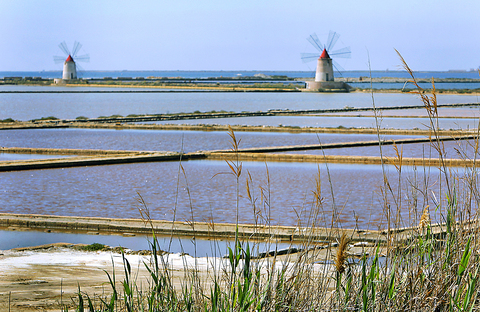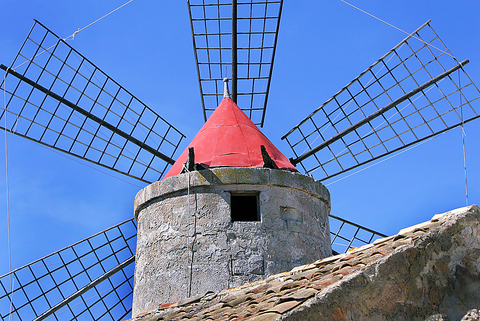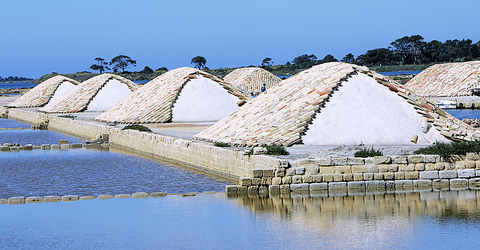Thousands of years ago, before Sicily became famous as the birthplace of the Mafia; before it retired the prize for the world's perfect oranges; before it was conquered by the Italians, or the Saracens, or even ancient Rome, this sprawling Mediterranean island was fiercely prized for its rich annual haul of salt.
When no one could imagine such a thing as a refrigerator, salt was by far the best way to preserve food. It was shipped across the sea, used as money, mixed into paste, and sculpted into jewelry.
Sicilians along the island's smooth western shore, blessed with saline water and hot windy summers, found themselves sitting on an almost priceless resource. They refined the technique of raking salt out of evaporated seawater, transforming the coast into a vast salt factory dotted with ponds, sluices, and nearly priceless white mounds.

PHOTOS: NY TIMES NEWS SERVICE
Two thousand years later, salt costs a US dollar a can in every supermarket in the world, and Sicily's biggest export for the past half-century has been its people. Modernity has created deep contradictions here: Tourists flock to extraordinary Greek ruins and the terraced four-star hotels of the east coast. There's a ski resort on volcanic, 3,352m Mount Etna. Behind that facade, the island remains a network of farms and poor villages struggling to lift itself from its corrupt feudal past.
But I had also heard that on the remote west coast there were still wide, shallow pools of seawater, and still a handful of people who spent Sicily's excruciating summer months raking evaporated slush into mounds of white crystals. It sounded so pointless, so labor-intensive, so Italian. Of course, I had to see it.
We were going to Sicily in any event. My wife studies ancient art, and we had mapped out a two-week trip around the island to see the remnants of Greek and Roman rule. The salt would require a modest little detour to the coastal city of Trapani, the unofficial capital of the salt industry.

It was March, well before the tourist season. To the east, resort hotels were just starting to unfurl their awnings. In the mountainous heart of the island, stiff winds were kicking up squalls of snow. Airport posters always make Sicily look like the Costa Brava, a playland of golden vineyards and beach umbrellas, but not this time of year. I stuffed my bathing suit into the bottom of my suitcase and bought a pair of thick felt pants.
We rented a white Fiat with a trunk that barely closed over our bags and headed west, away from the capital Palermo and the big resorts. I had been warned about the terrors of driving in Sicily, but we floated almost calmly across its broad ribbon highways, cutting through green hills speckled with the island's ubiquitous half-built concrete apartments. We laughed about our car's tiny engine and its tiny name — Punto, the Dot — until we started noticing other Fiat Puntos passing us at 193km an hour, straight into oncoming traffic. Far sooner than we expected, maybe an hour from the airport, we found ourselves approaching the salt coast.
The remnants of the salt industry may not be among the great tourist pilgrimages of the Mediterranean, but we didn't have much trouble tracking them down. Road signs marked out the Via del Sale, or Salt Road, which runs south from Trapani to the next coastal city, Marsala.

We followed it out of town and the road opened up to a series of flat coastal farms. As we approached the shore, the farms gave way to something strange: huge rectangular fields of water. The interconnected shallow pools line the coast for kilometers, sprinkled with windmills only recently supplanted by newer ways to pump water and grind salt crystals.
Our destination was the obvious one: the Museo delle Saline. The museum doesn't have an address, so we followed signs through a townlet called Nubia and hoped. At the edge of an aquatic nature reserve, under a flat sunny haze and a stiff wind, we turned into a parking lot with a single low stone building.
The museum has a restaurant for seasonal visitors and a gift shop, but when we got there the restaurant was closed. In fact, the entire parking lot stood empty except for one car that was stationed, strangely, right across the front entrance. As we approached, the car door opened and a woman got out. "Museo?" we asked her. She was the curator. We were the only visitors.
The salt museum isn't big, but like many specialized museums it conveys a kind of dusty intensity about its subject. I had assumed salt would be a pretty idiot-proof crop: You let a bunch of seawater evaporate in the sun, and when it's crunchy and white, you're done. Not quite. If it evaporates too fast or too slowly, other substances — bad substances — crystallize out of the seawater and you end up with bitter salt, or metallic salt, and some Phoenician or Aragonese prince tortures you until you get it right. Saltmaking turns out to be an art: The seawater flows into a giant lagoon, and then is pumped into a hierarchy of evaporating pools, each with its own depth, temperature, and name.
The museum's walls were covered with complex diagrams and tables of salinity, as if to say: We know you thought this was easy. Massive wooden wheels and Archimedes' screws evoked decades of backbreaking labor. The salt flats had a human hierarchy, too, in which the water was carefully tasted and monitored by a curatolo, whose father had taught him how to tell when the salt was ready. Everything in the museum — the walls, the charts, the equipment — seemed covered with a fine white dust. I rubbed my finger on the dust and licked it. Salty.
Sicilian salt has a reputation for tasting like minerals and being quick-dissolving; its proponents cite its high magnesium content as a culinary virtue. I could never tell the difference. For me, the crunch and spark of salt in Sicily was like drinking a glass of wine in a vineyard: Somehow the stuff just tastes better if you're standing on the slice of earth that produced it.
As it turned out, we were there at the wrong time to see any saltmaking. Harvest season wouldn't begin until midsummer, when wet salt floats to the surface of the last pools like a crown of heavy spring snow. Seasonal workers rake the slush off, shape it into long pyramidal mounds, and cover the mounds with roofing tiles. All we could see here was the remainder of last year's harvest. Under their red tile covers, the piles of salt looked like peaked roofs with no houses below, a subdivision built from a condiment.
We made our way down the coast, following the salt road. We passed fields, fences, low farmhouses; one dead end took us to a windmill. Another turn took us to the ferry dock for the privately-owned island of San Pantaleo and another sort of salt museum: a working salt mill called the Saline Ettore e Infersa.
The coast was warm, quiet, sleepy. Nearby, an old man sold fake Phoenician antiquities out of his car. A cafe sold espresso and juice hand-pressed from Sicilian mandarin oranges. Vines trailed in the sun. Again, there was almost no one there but us.
Today, Sicily runs on almost everything except salt. That night we stayed at a converted farmhouse called the Duca di Castelmonte. Our host's last name, Curatolo, spoke of a family history at the top of the salt hierarchy, but he made his living from a farm, an inn, an olive oil business, and a soccer club. He also possessed a resource now more greatly prized than salt: the best cook anywhere for kilometers.
The point of salt, of course, is to put it on food. I'm not saying it was the salt, but our first dinner at the Curatolo farmhouse was like nothing you could imagine, one dish after another made with local ingredients, flavored with local olive oil. A clear cauliflower soup; a warm eggplant caponata; pounded steak seared in oil. Dinner ended with an unusual local liqueur made from fennel.
We would spend another 10 days in Sicily, visiting the famous parts and eating spectacularly well — unusual almond pesto, cheese grilled on an open fire, calamari hauled straight from the sea. We rarely saw any salt. At Italian tables, the presumption is that the chef does it right the first time. When we did ask for salt, we looked at it carefully. It rose in telltale clumpy mounds, the mark of sea salt still holding a bit of the moisture of the ancient salt pans. When we put it on our tongues, it tasted ... well, it tasted pretty much like salt.

Taiwan doesn’t have a lot of railways, but its network has plenty of history. The government-owned entity that last year became the Taiwan Railway Corp (TRC) has been operating trains since 1891. During the 1895-1945 period of Japanese rule, the colonial government made huge investments in rail infrastructure. The northern port city of Keelung was connected to Kaohsiung in the south. New lines appeared in Pingtung, Yilan and the Hualien-Taitung region. Railway enthusiasts exploring Taiwan will find plenty to amuse themselves. Taipei will soon gain its second rail-themed museum. Elsewhere there’s a number of endearing branch lines and rolling-stock collections, some

The Democratic Progressive Party (DPP), Chinese Nationalist Party (KMT), and the country’s other political groups dare not offend religious groups, says Chen Lih-ming (陳立民), founder of the Taiwan Anti-Religion Alliance (台灣反宗教者聯盟). “It’s the same in other democracies, of course, but because political struggles in Taiwan are extraordinarily fierce, you’ll see candidates visiting several temples each day ahead of elections. That adds impetus to religion here,” says the retired college lecturer. In Japan’s most recent election, the Liberal Democratic Party lost many votes because of its ties to the Unification Church (“the Moonies”). Chen contrasts the progress made by anti-religion movements in

Could Taiwan’s democracy be at risk? There is a lot of apocalyptic commentary right now suggesting that this is the case, but it is always a conspiracy by the other guys — our side is firmly on the side of protecting democracy and always has been, unlike them! The situation is nowhere near that bleak — yet. The concern is that the power struggle between the opposition Chinese Nationalist Party (KMT) and their now effectively pan-blue allies the Taiwan People’s Party (TPP) and the ruling Democratic Progressive Party (DPP) intensifies to the point where democratic functions start to break down. Both

This was not supposed to be an election year. The local media is billing it as the “2025 great recall era” (2025大罷免時代) or the “2025 great recall wave” (2025大罷免潮), with many now just shortening it to “great recall.” As of this writing the number of campaigns that have submitted the requisite one percent of eligible voters signatures in legislative districts is 51 — 35 targeting Chinese Nationalist Party (KMT) caucus lawmakers and 16 targeting Democratic Progressive Party (DPP) lawmakers. The pan-green side has more as they started earlier. Many recall campaigns are billing themselves as “Winter Bluebirds” after the “Bluebird Action”